Between coordinating with your team, reviewing content, running paid campaigns, and putting together reports, the workload doesn’t let up.
I’ve been there; juggling client requests, trying to keep processes smooth, and still finding time to actually think strategically.
That’s exactly why I’ve spent time testing and reviewing the top social media management tools that agencies are using in 2025.
But before we get to the list, let’s understand when agencies actually need a social media management tool in the first place.
When Should Agencies Use Social Media Management Tools?
If you’re managing a few clients, you can probably hop between platforms.
Here’s when things start to break down and when you realize you need a proper system in place:
1. Your clients are not willing to share their social account passwords
Most clients aren’t comfortable handing over their social media passwords.
A proper social media management tool solves that.
Clients can securely connect their accounts to the dashboard without sharing credentials.
From there, you and your team get the access you need to publish content, monitor and respond to engagement, and prepare reports without asking your clients for passwords.
2. You're managing more than five clients
Once you start juggling more than five clients with different brand voices, time zones, and approval processes, it becomes painfully obvious that you need more structure.
Because switching between accounts and tools will slow you down. Worse, you can accidentally post one client’s updates on another client’s account.
That’s when you realize you cannot rely on memory and tabs anymore.
3. You have a team
The moment you aren’t the only one managing your client’s social media, things start getting messy, real fast.
Google Docs with feedback, Slack messages with changes, email threads with “final” posts… it is a lot to handle.
A tool with approval workflows and real-time comments will save you hours and your clients from reviewing half-baked content.
4. Clients want regular reports and want to see ROI
At some point, clients start asking, “How did the previous campaign perform?” or “Can you show what’s working this quarter?”
If you don’t have a tool that pulls clean and accurate reports quickly, you are stuck building slide decks manually and screenshotting analytics from multiple different platforms.
With a social media management tool, you get customizable, client-ready reports. You can also schedule reports to send automatically on a recurring basis and even brand them with your agency’s logo.
5. You’re spending too much time posting
Scheduling one post at a time means opening the social network, pasting a caption, uploading an image, checking the preview, and clicking post.
Multiply that by five clients, seven days a week, and you are losing whole afternoons.
Bulk scheduling changes that. You can schedule a month’s worth of posts in one sitting by using a CSV upload, so you get more time to focus on the strategy side.
6. You want to stop putting out fires
Before using a management tool, I was in reaction mode all the time. I’d miss DMs. I’d scramble to find assets. I’d forget which version of the caption the client approved.
With a social media engagement tool, everything is in one place: messages, drafts, approvals, assets, hashtags, and scheduled content. Now there are fewer last-minute panics.
Now that I have covered the “when,” let’s get into the list of tools that can actually help you make this happen.
Top 10 Social Media Management Tools for Agencies in 2025
In curating this list of agency social media management tools, I have considered factors such as ease of use, collaboration features, scheduling and publishing, inbox management, reporting capabilities and pricing, and scalability.
Statusbrew
Social Integrations: Facebook, Instagram, X, LinkedIn, Pinterest, TikTok, Google My Business, Threads, Bluesky, and YouTube.
Statusbrew is for agencies that manage multiple clients and require operational clarity, scalability, and control.
And unlike some tools that hike up costs as your team expands, Statusbrew scales with you without demanding a huge budget.
It provides a centralized dashboard where each client’s data can be kept separate in workspaces.
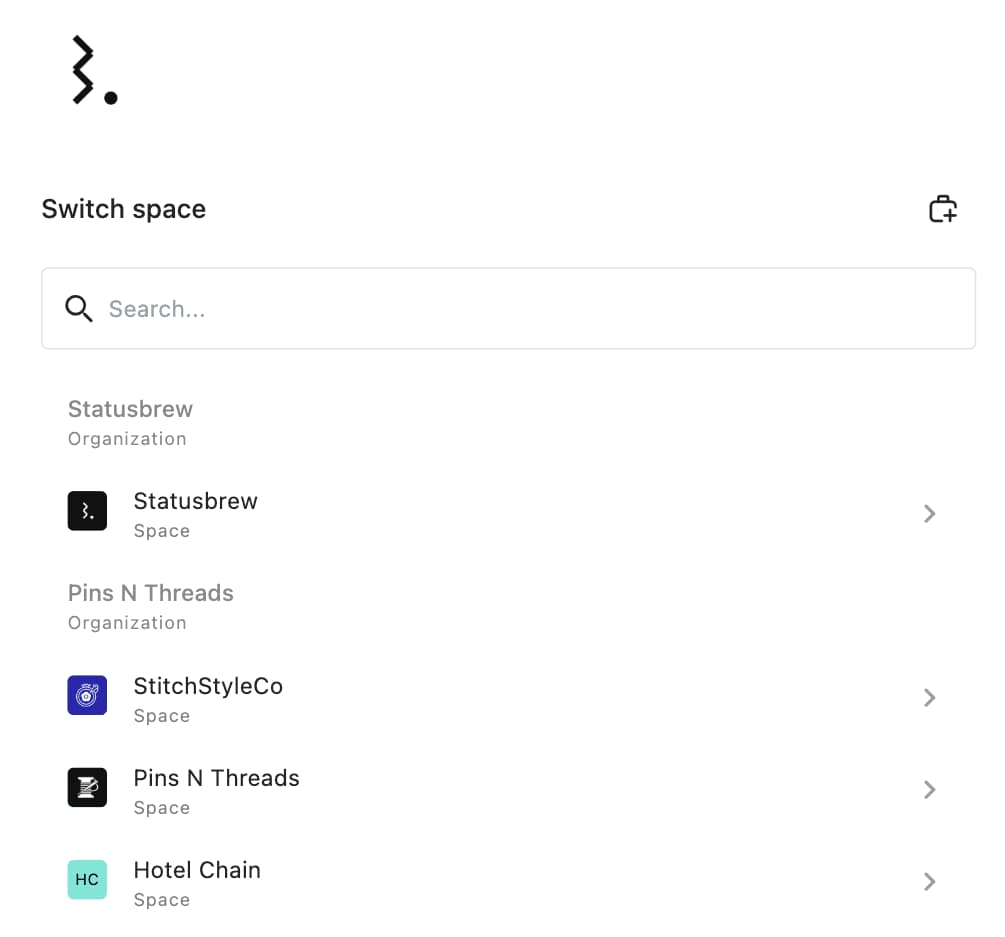
If you still want everything in one workspace, Profile Groups let you organize social media profiles by client so you can assign permissions, manage posts, and track analytics.
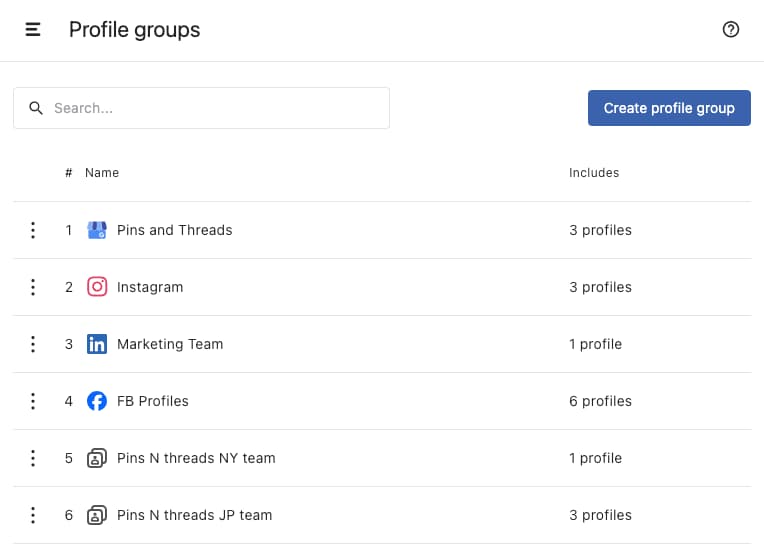
User Groups can be used to manage team members and their access to specific profiles.
Statusbrew reduces the need for planning tools like Spreadsheet, Notion, Asana, and Trello.
Teams can plan social media, assign tasks, and track progress from the platform.
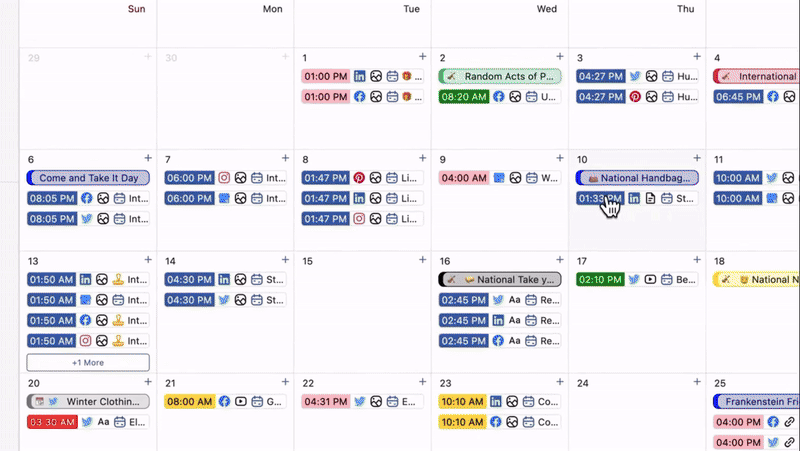
You can schedule all content types, such as image posts, text posts, GIFs, reels, stories, carousels, and video content, up to 12 months in advance.
Collaborate internally or externally to get opinions on the content calendar created.
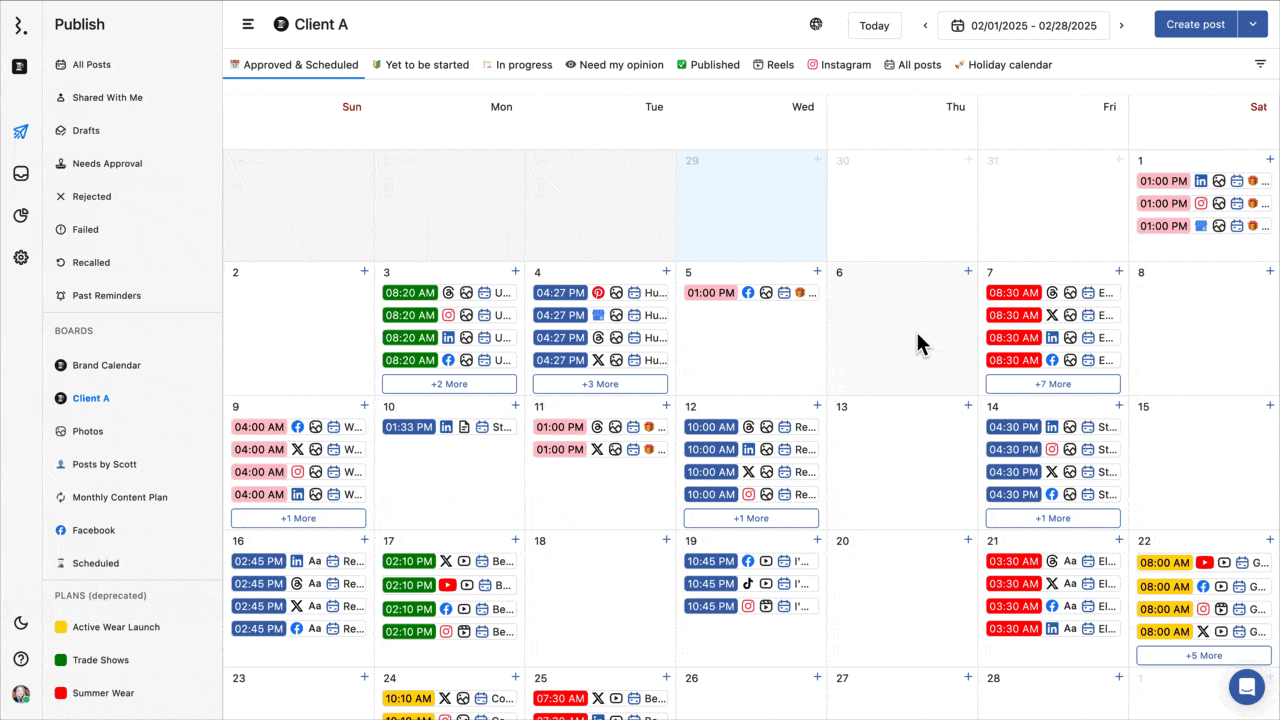
You can save hours by bulk scheduling almost 400 posts 6 months in advance with CSV uploads.
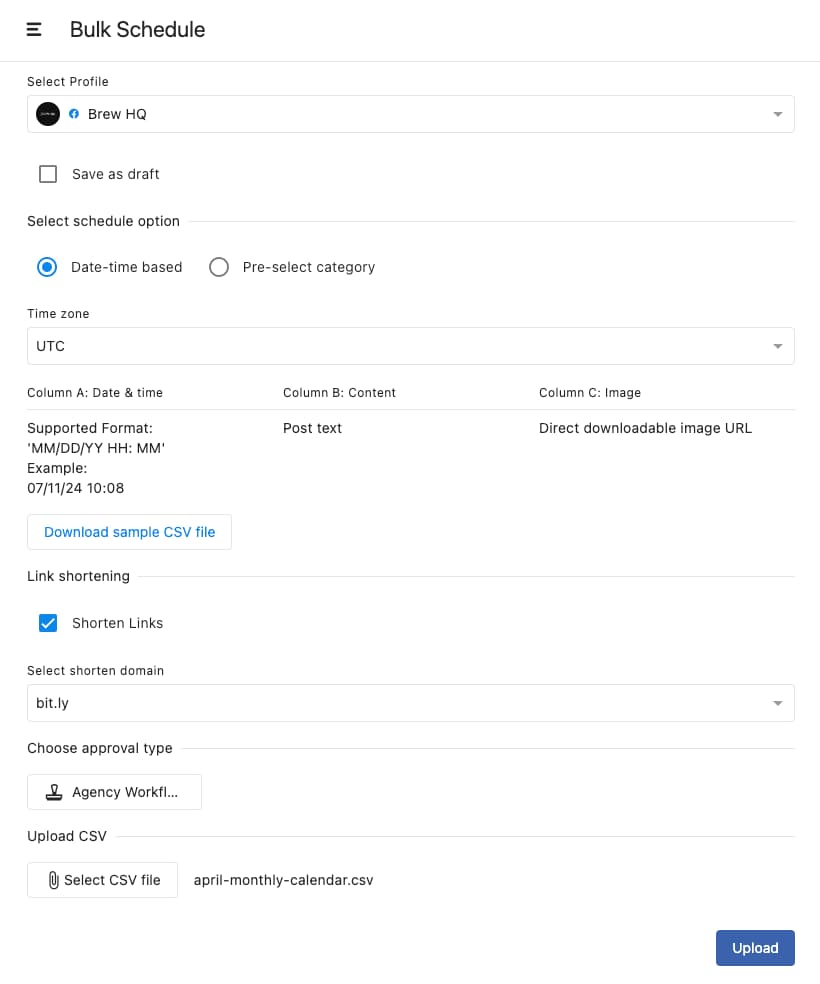
It even provides suggestions on the best time to post so you can schedule posts for the highest engagement.
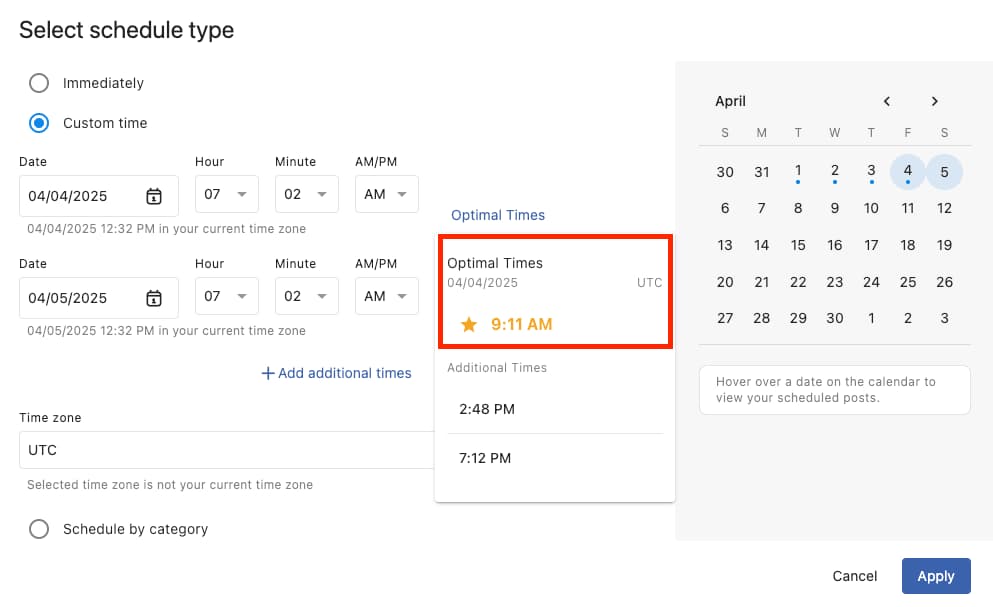
You can also create multi-user, multi-step approval workflows that are customizable so that each client has its own review process based on its responsibilities.
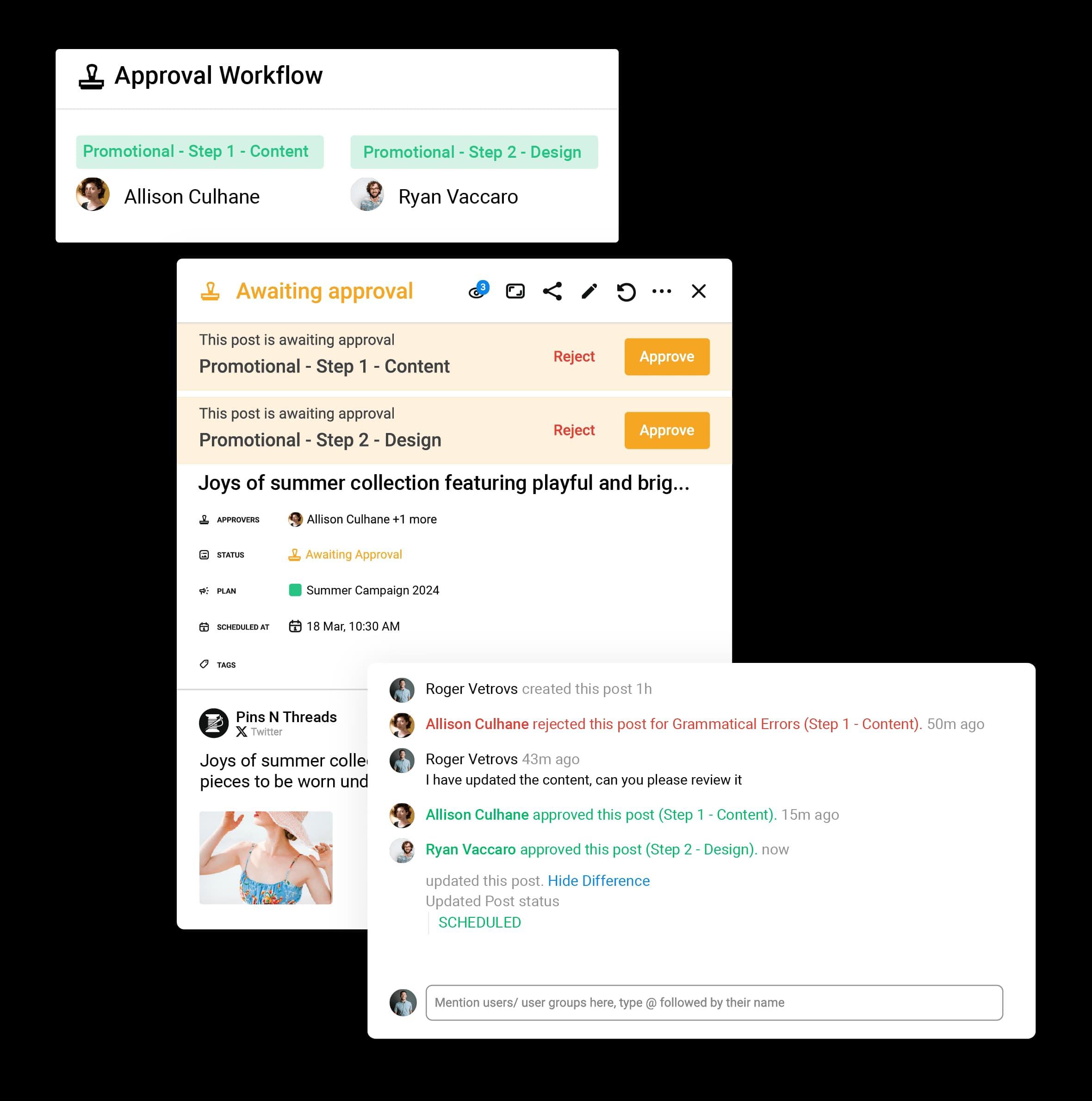
Content calendars are shareable with people outside the platform, who can view, comment, or suggest edits without logging in.
Calendar events allow teams to annotate campaign plans, seasonal events, and holidays in one view.
Statusbrew gives agencies a unified inbox that consolidates all organic and paid conversations for all supported platforms.
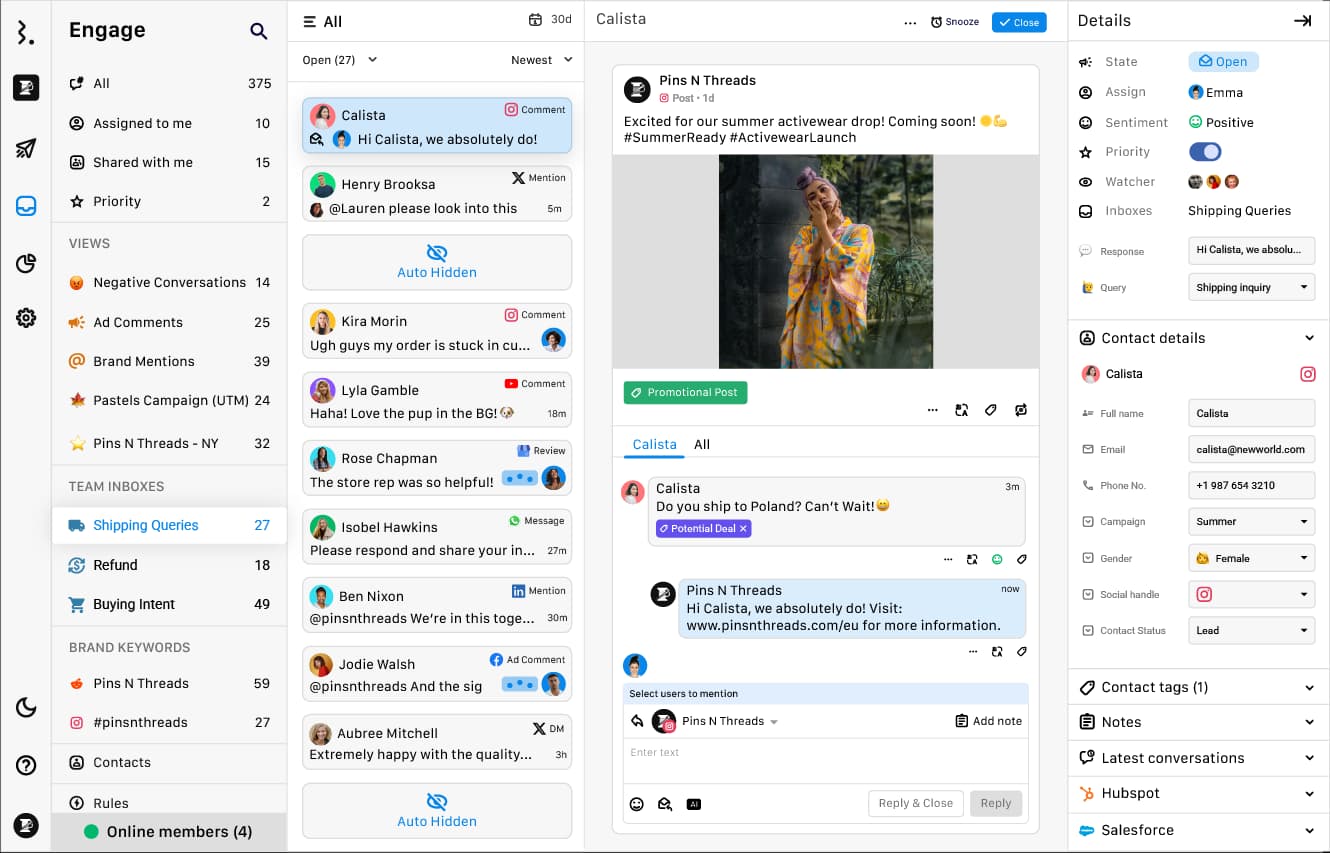
With over 25 filter combinations, your team can create customized inbox views and focus on conversations that matter most.
Statusbrew also supports TikTok DMs.
You can assign messages to the right team member. Add internal notes to give context, align on replies, and move faster as a team.
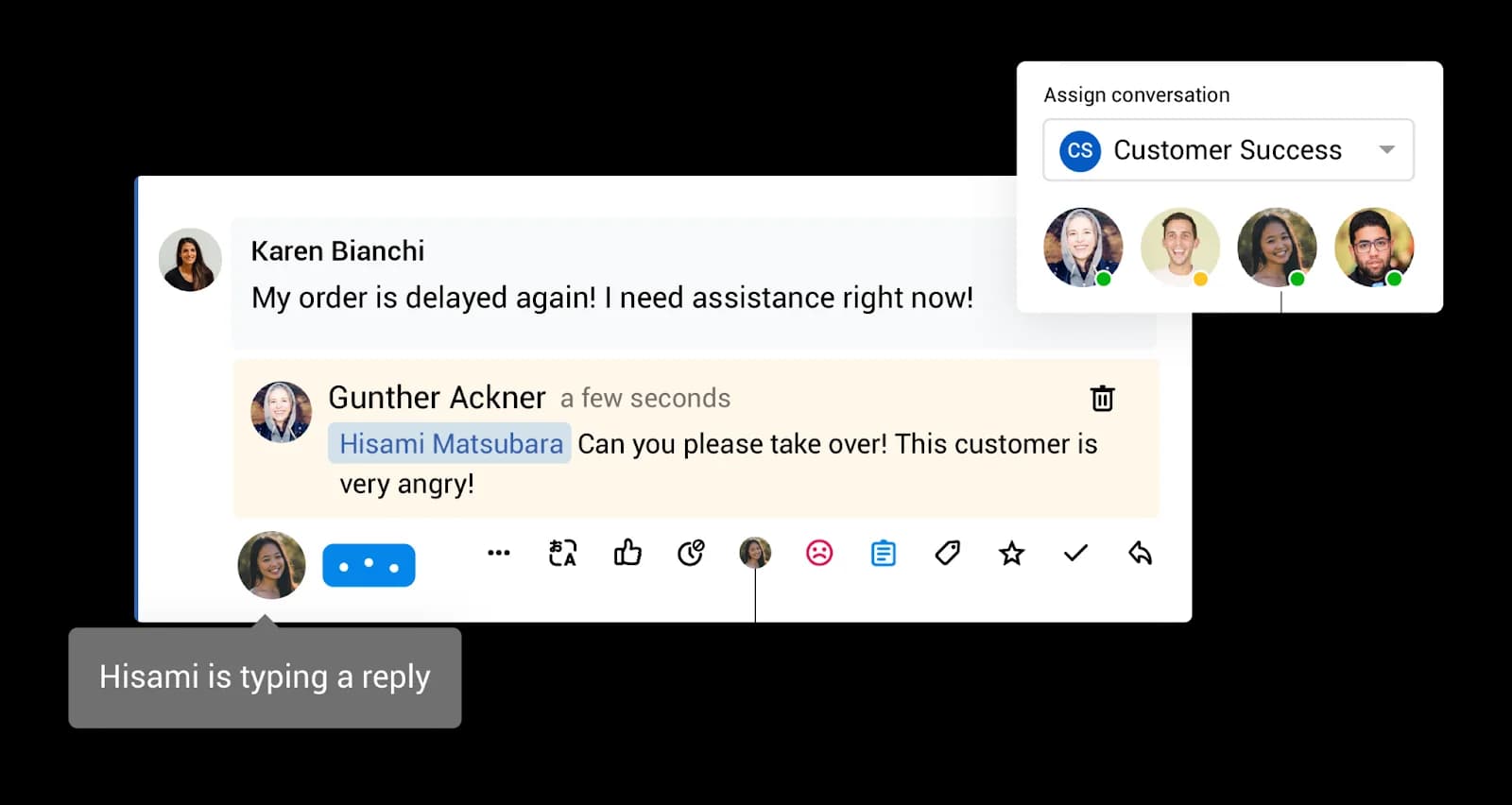
Statusbrew’s social listening tool monitors keywords, hashtags, and brand mentions across platforms like Instagram, X, Reddit, and Web (blogs, & news outlets). That means you can keep tabs on brand sentiment, spot trends, and stay ahead of competitors.
Tagging helps keep content, conversations, and contacts organized.
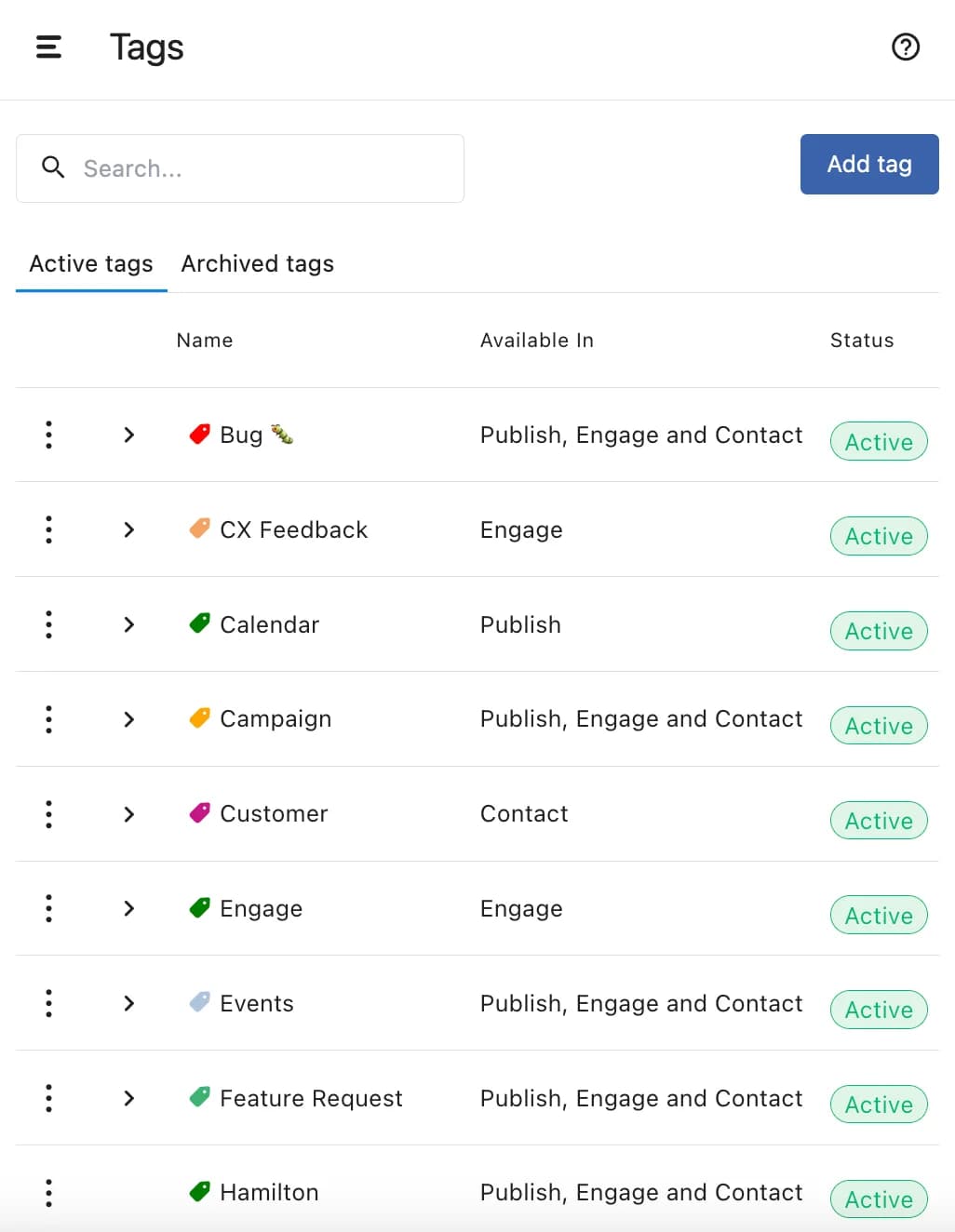
Your team can answer recurring questions quickly and with consistency by building a bank of pre-approved replies.
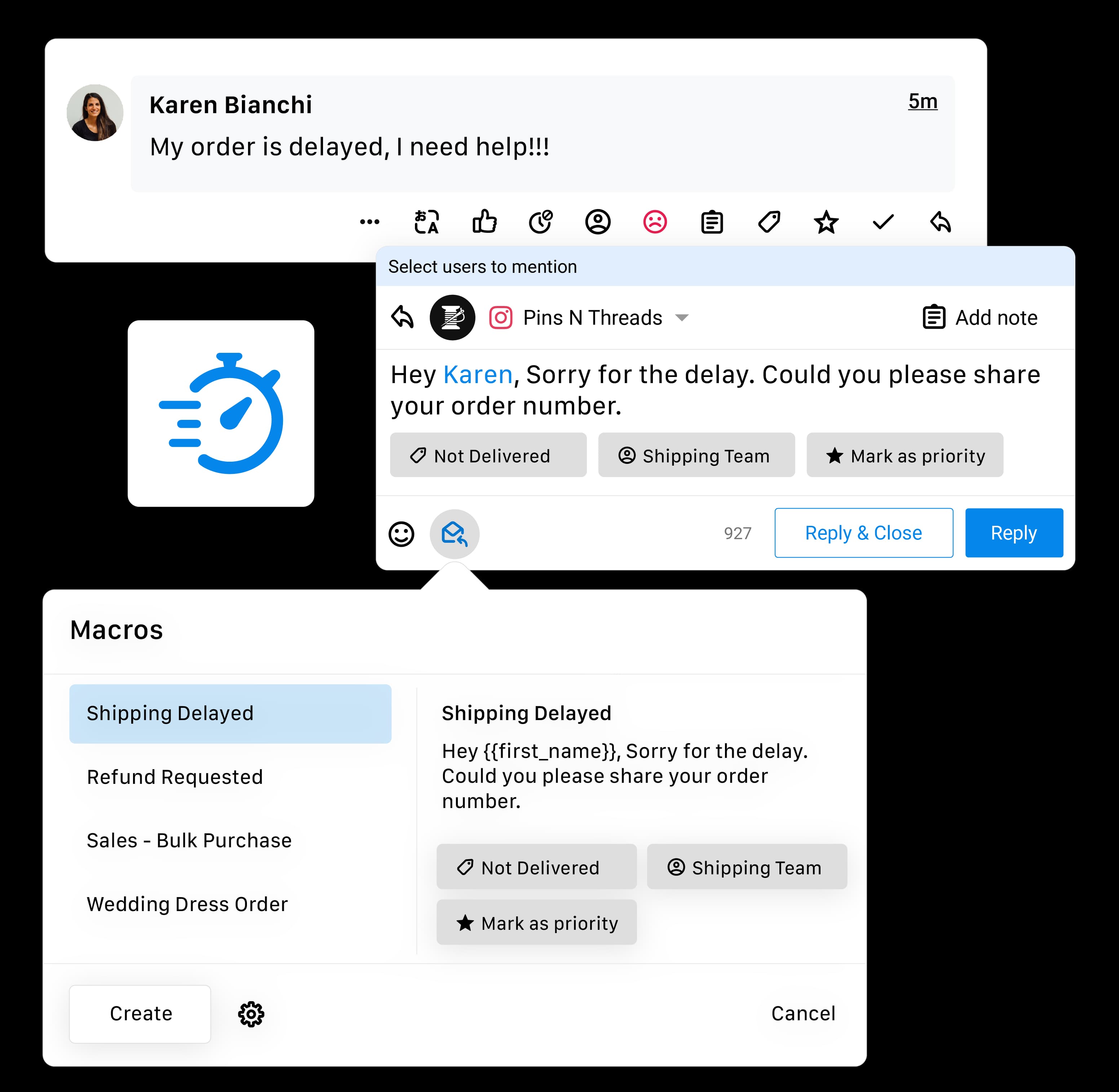
With over 68 customizable rules, you can:
Automatically hide or delete negative comments on organic or paid posts
Trigger auto-replies to FAQs
Route messages by priority or topic
Auto-assign tickets to the right person
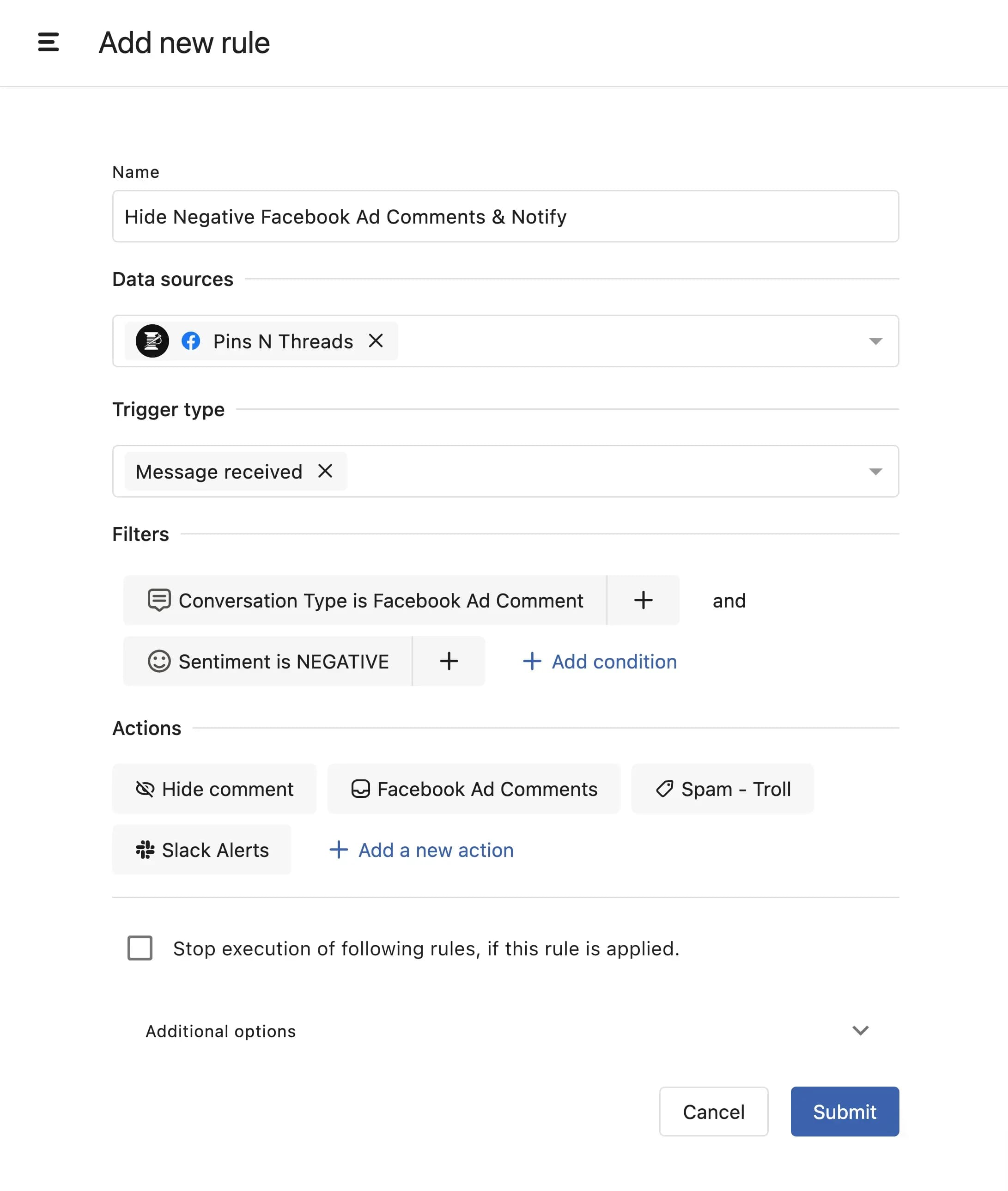
Example of a rule to hide negative Facebook ad comments
Entire comment threads on Facebook and Instagram can be hidden or deleted with a single click, up to 4,000 comments at once.
Statusbrew gives agencies full control over reporting, without needing to build everything from scratch.
You can create custom dashboards that align with your client’s social media goals using a library of over 230 metrics.
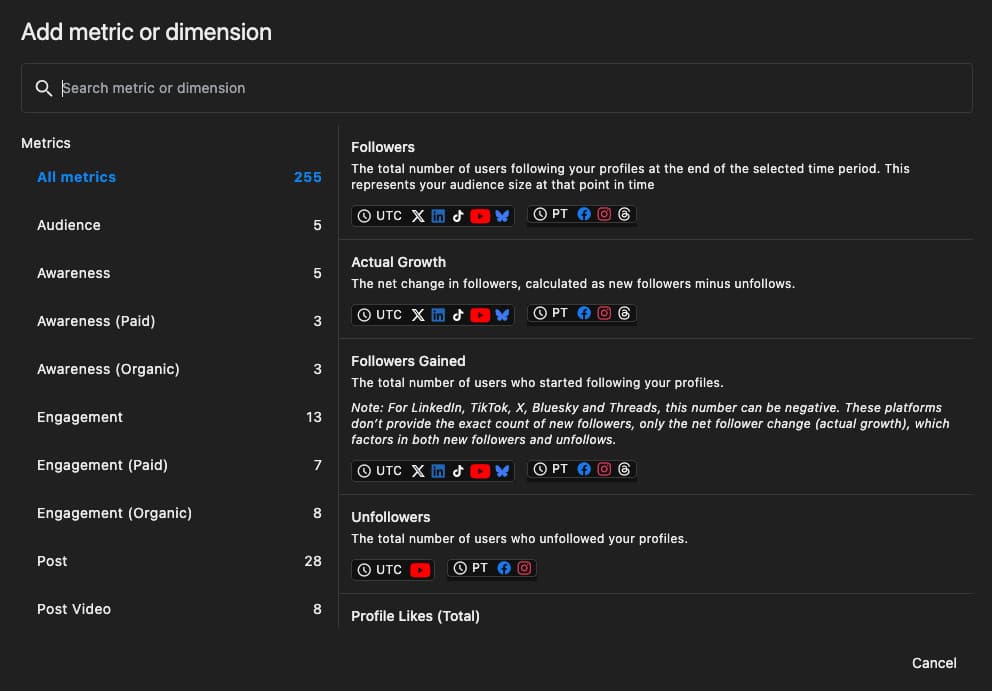
Combine any metric with any of the 11 visualization formats, and layer on filters like profile, time range, or user role to fine-tune the view.
If you need to move fast, choose from 20+ built-in reporting templates. You still get full editing control to adjust charts, timeframes, or metrics as you need.
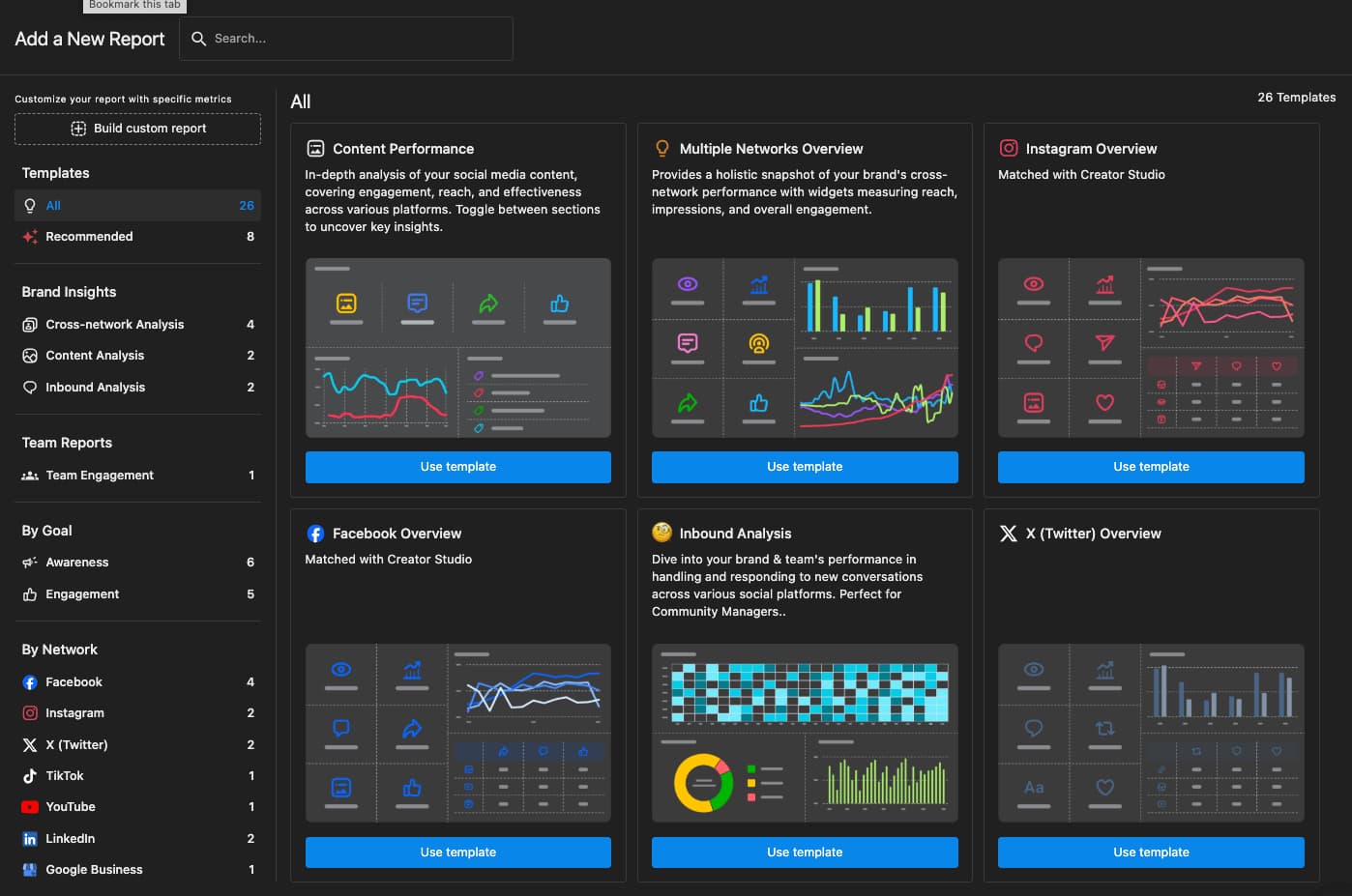
Here are a few more reporting templates that are especially helpful for agencies:
Facebook Overview (Organic & paid)
Reports can be set to go out on a fixed schedule, daily, weekly, or monthly, so your clients stay informed without extra effort.
Share these with clients or internal teams through secure, shareable links that let you control exactly what they see.
You can also set link expiry dates to limit access after a certain period, lock the date range to ensure the data isn’t adjusted, and even add external users to the report without giving them full platform access.
Pricing:
Statusbrew’s pricing starts at $49 per client per month.
That includes support for multiple social profiles per client, no cap on user seats, and full access to all features, whether you’re managing one client or ten.
You don’t need to worry about hitting a paywall as your team grows or your client's needs expand.
Anxious about Data Migration?
We can set up reporting dashboards for you, along with up to 18 months of data backfill.Sprout Social
Social Integrations: Facebook, Instagram, X, LinkedIn, Pinterest, TikTok, Google My Business, Threads, and YouTube.
Sprout Social offers a full suite of tools to support agencies in managing multiple clients.
It's not the cheapest option out there.
Sprout stands out for its analytics depth and CRM integration.
Social listening tools go beyond monitoring mentions. They help shape content strategies based on actual trends and sentiment shifts.
Sprout’s publishing suite has what most agencies need: multi-user collaboration, role-based permissions, and a solid approval process.
Sprout’s inbox is unified and includes filtering, tagging, and team assignments.
One of the biggest wins with Sprout is reporting. The reports are exportable, customizable, and client-ready. You can automate delivery, white-label them, and even control which metrics a client sees.

With Sprout’s CRM features, you can track conversations, label customer types, and even assign follow-ups based on team member availability.
Pricing:
Sprout Social follows a per-user pricing model, starting at $199 per user per month, which can quickly add up for larger teams.
If your team has just five people involved, you’re looking at nearly $10,000 a year.
What you do get starting from the Professional Plan ($299 per user per month) is the ability to connect unlimited social profiles. That’s genuinely helpful for agencies with a growing client list.
That said, I found it a little frustrating that some features you'd expect to be standard, like competitor tracking, saved replies, message tagging, and bulk scheduling, are locked into that higher pricing tier (starting at $299 or $399 per user per month).
If you're currently using Sprout Social or considering it, it's worth taking a closer look at its pricing structure alongside what it’s competitors offer.
We've covered both in detail across our blogs on Sprout Social pricing and alternatives to help you make a more informed decision.
Hootsuite
Social Integrations: Facebook, Instagram, X, LinkedIn, Pinterest, TikTok, Google My Business, Threads, and YouTube.
If you’ve been in the social space for a while, chances are you’ve already heard about Hootsuite at some point.
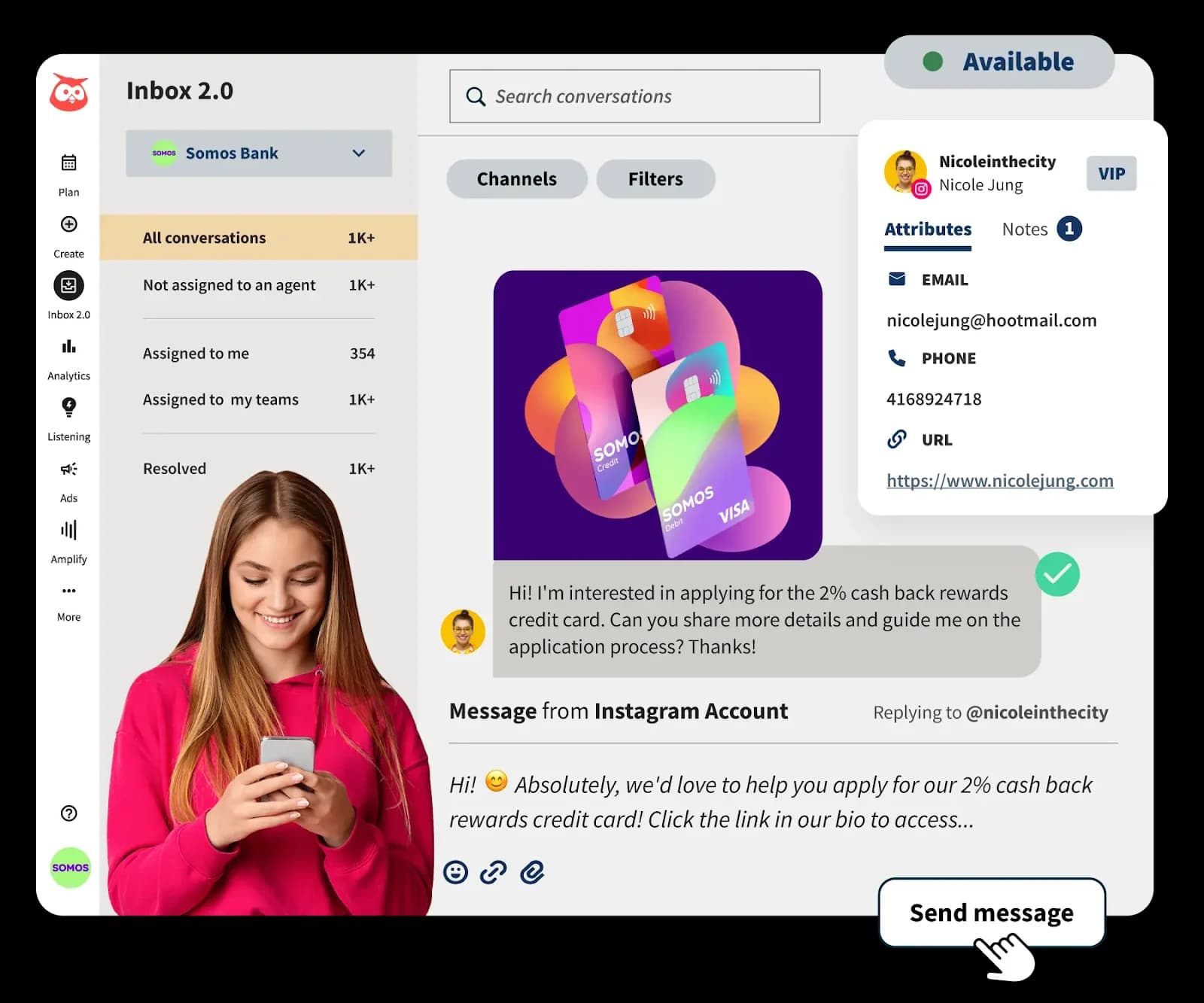
That familiarity is a plus when you’re onboarding a new client, as there’s less friction.
The dashboard layout and tab-based stream system feel easy to navigate.
Hootsuite’s main strength is still its ability to publish content across multiple social media platforms from one place.
The calendar view gives you a solid overview of what’s scheduled and where the gaps are.
You can set permissions and assign tasks like responding to comments or approving content, which is essential once you’re managing multiple brands.
While the approval workflows aren’t as nuanced as Sprout Social, they do the job for simple team setups.
Hootsuite has analytics, but they feel rigid. You can export PDFs and CSVs, and create basic reports, but the customization options don’t quite meet the mark.
While the dashboard does its job, it doesn’t feel as smooth or modern as other tools in this space.
It gets the task done, but it’s not the most pleasant to use daily, especially if you’re managing a larger volume of content and engagement.
One of Hootsuite’s strong points is its ecosystem. The platform integrates with over 150 external tools, including Canva for creating visuals, Google Drive and Dropbox for storing files, and Trello for project tracking.
Pricing:
Hootsuite’s pricing structure is one of the biggest hurdles for agencies.
While it starts at $149 per month, the moment you need real team features, you're looking at the Enterprise plan, which begins around $1,000 per month.
The “Team” plan at $399/month includes three users, but oddly, you can’t add more team members. You’re stuck.
Even within that team plan, the collaboration features are limited. You can assign roles and delegate incoming messages, but there’s no visibility into team activity or performance.
If you’re expecting approval workflows, tagging, alerts, or automated reports, those are locked behind the Enterprise plan.
Its pricing model relies heavily on add-ons. This pricing model often leaves agencies paying more than expected, especially if you're scaling.
If you’re weighing up Hootsuite or starting to feel boxed in by its limitations, it’s worth comparing what other platforms offer out of the box.
If you wish to compare both leaders, read our blog, Sprout Social vs Hootsuite.
Sprinklr Social
Social Integrations: Facebook, Instagram, X, LinkedIn, Pinterest, TikTok, Google My Business, Threads, and YouTube.
Sprinklr Social is built to meet enterprise needs. Agencies working with large brands or handling complex requirements won’t find a more comprehensive and scalable platform.
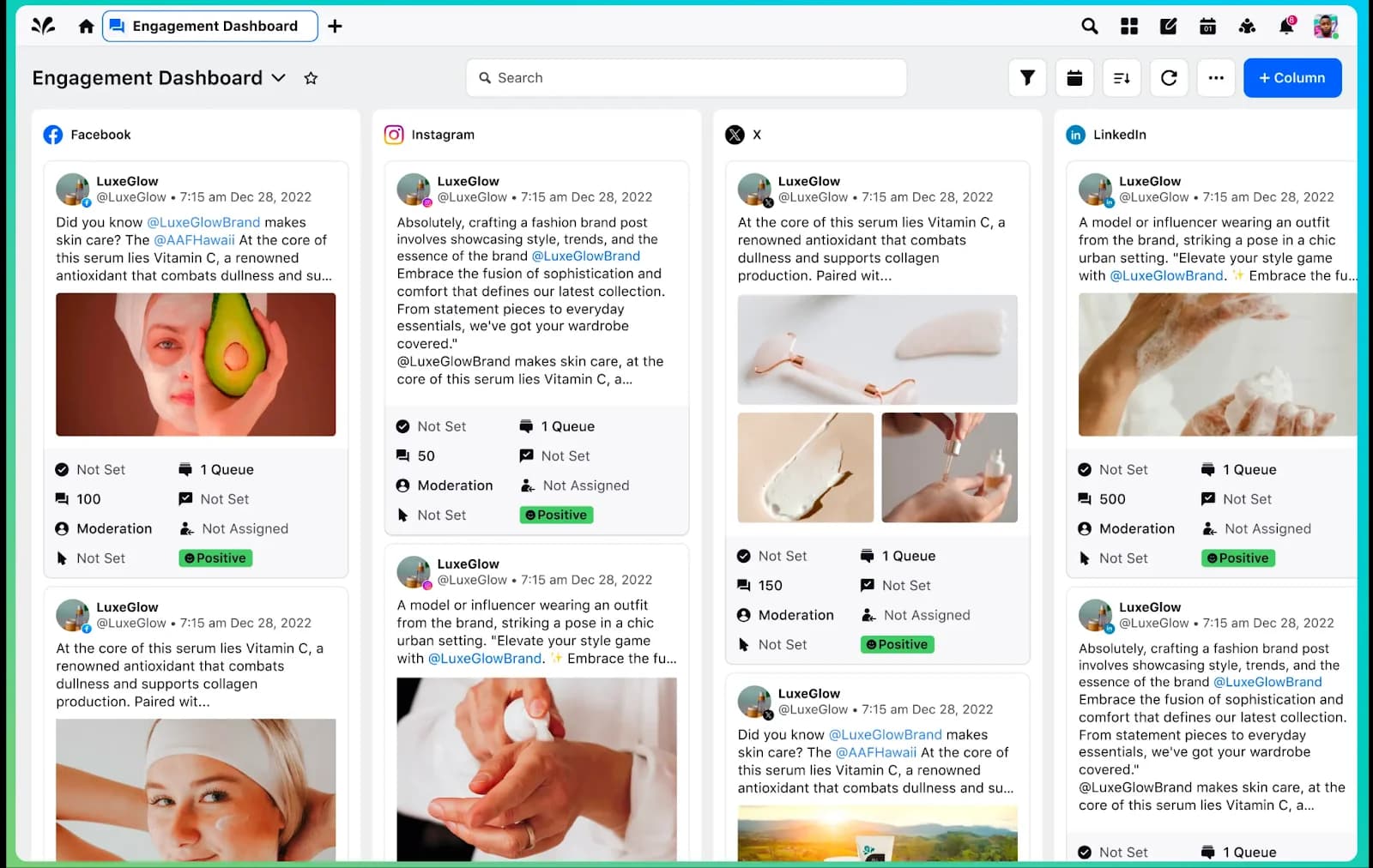
From a social media agency’s perspective, Sprinklr offers a level of depth and control that’s hard to beat, but with that power comes complexity.
You can build highly customized workflows for content approvals, moderation, publishing, and reporting.
If you have clients with strict brand guidelines, global reach, or multiple stakeholders, this level of configuration is truly helpful.
Sprinklr shines in scale. You can manage thousands of profiles across networks and never lose track.
Reports in Sprinklr are strong, but the learning curve is steep.
If your clients want granular performance metrics, sentiment analysis, and cross-channel comparisons, it’s all there. You just need time (and often training) to build it out.
From my experience, this pays off only if you’re running large accounts that demand that level of depth in reporting.
Pricing:
But this all comes at a price. Sprinklr is rarely a cost-efficient choice for smaller agencies.
It’s built for scale, and while it delivers on that front, the upfront investment (in both money and training) is something to think about.
Sprinklr Social offers custom pricing (annual costs ranging from $100,000 or more) after discussing your requirements during a demo call.
Agorapulse
Social Integrations: Facebook, Instagram, X, LinkedIn, Pinterest, TikTok, Google My Business, Threads, and YouTube.
If you're running a small or mid-sized agency and keeping an eye on your software spend, Agorapulse hits a nice balance.
It gives you solid scheduling, engagement, and reporting tools without charging extra for features that should be standard.
If your agency is working with enterprise clients or large multinational brands, Agorapulse can feel a bit lightweight.
It doesn’t offer the same depth of customization or workflow controls as Sprinklr or even Sprout Social.
But if your client list is growing and you want a tool that can keep up without overcomplicating things, Agorapulse makes a strong case.
The UI is simple. All the core features, from scheduling, community management, to reporting, are easy to use.
One limitation with Agorapulse’s inbox is that it isn’t unified. You have to manage messages on a profile-by-profile basis, which will slow things down when you're handling multiple accounts.
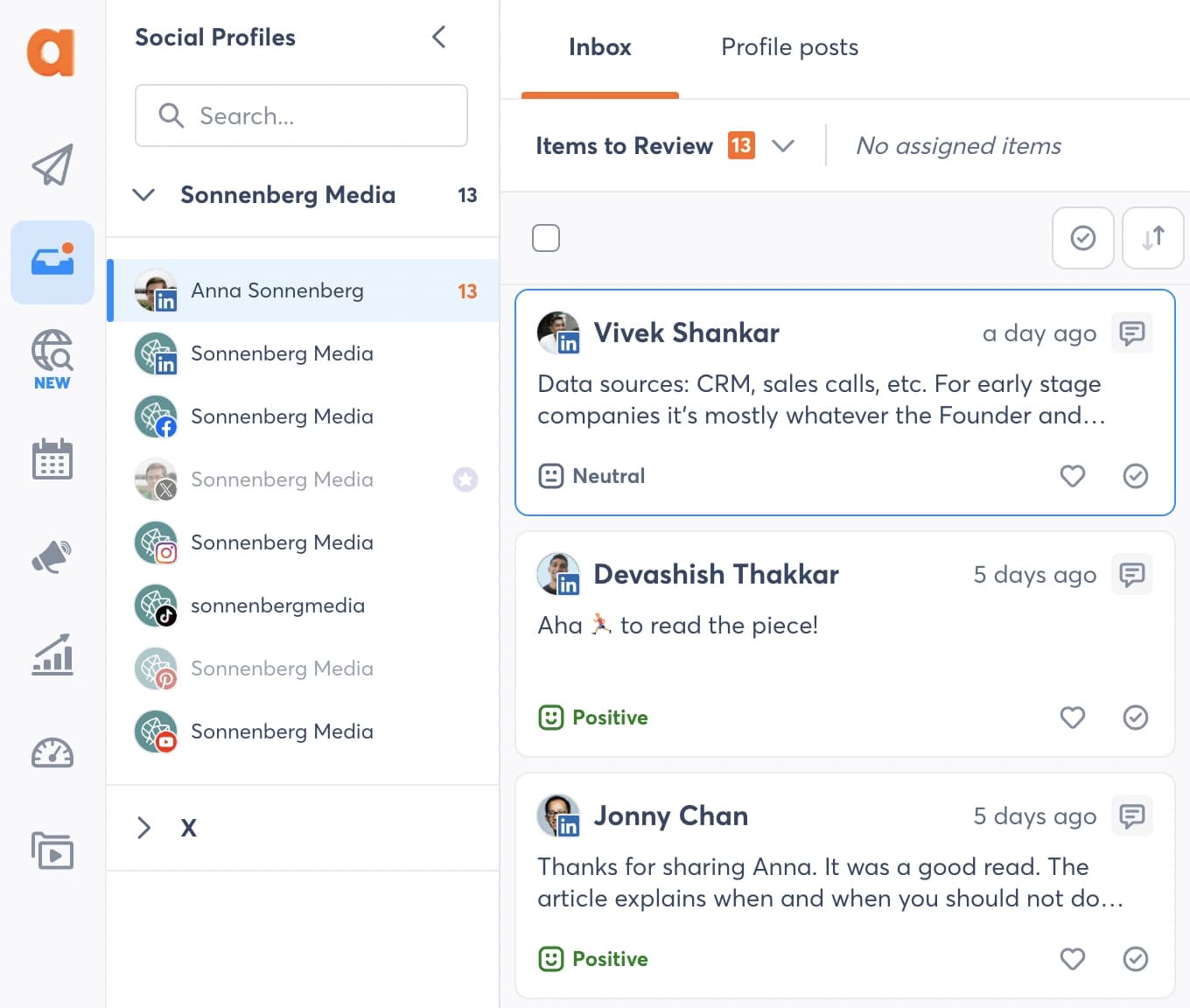
You can tag team members, leave internal notes, and send content for client approval.
Facebook and Instagram ad comment management is also built into the inbox.
You can build reports based on platform, campaign, or custom date ranges, then share them with clients via a link.
The Social Media ROI feature connects content performance to traffic, conversions, and revenue, allowing agencies to identify which platforms deliver results and adjust their strategy.
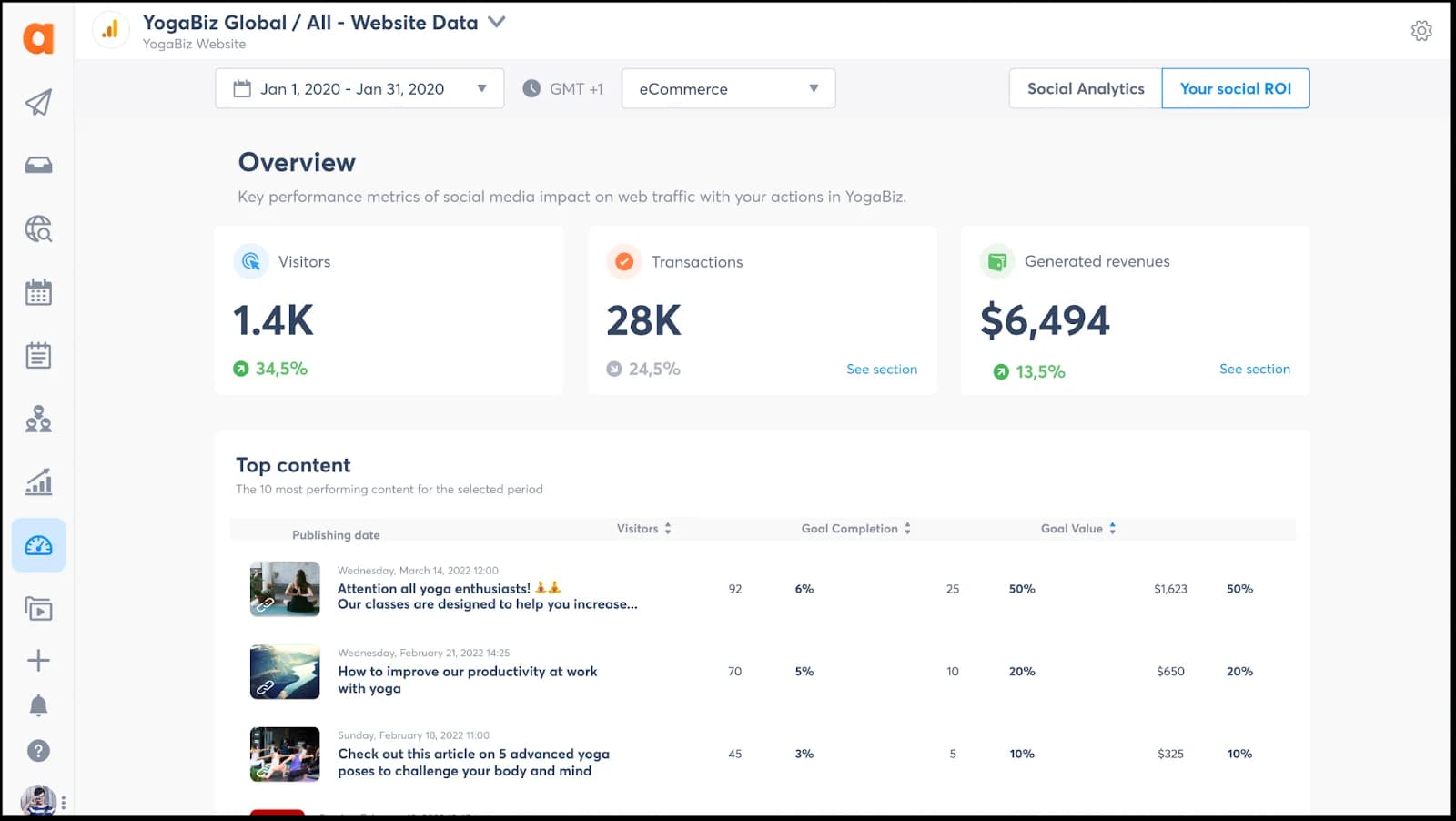
Agorapulse offers white-labeled reports. That means agencies can add their logo on client reports.
Pricing
Agorapulse, like Sprout Social, follows a user-based pricing model that starts at $99 per user per month.
But the features agencies actually need such as approval workflows, calendar notes, and team performance reports, are available from the Professional plan onwards, which bumps to $149 per user per month.
If you want shared calendars, bulk scheduling, or custom reports, you’ll have to opt for the Advanced plan, which starts at $199 per user per month.
Agorapulse’s pricing is transparent, but the value kicks in only once you're past the base tier.
If you're eyeing Agorapulse or already using it and find the profile-based inbox more frustrating than functional, I've broken down stronger alternatives in a separate blog.
Buffer
Social Integrations: Facebook, Instagram, X, LinkedIn, Pinterest, TikTok, Google My Business, Threads, YouTube, Bluesky, and Mastodon.
Buffer is a social media management tool that’s simple to use without cutting out important features.
It is a great choice for agencies in the early stages or handling a few clients.
The interface is clean and easy to use. You won’t waste time searching for buttons or hidden settings.
Scheduling posts is quick. Just add the content, choose the time, and you're done.
This is a big plus for agencies moving between multiple accounts or launching campaigns without spending too much time setting things up.
Buffer also makes managing content easy by having a clear and organized content queue for each social account.
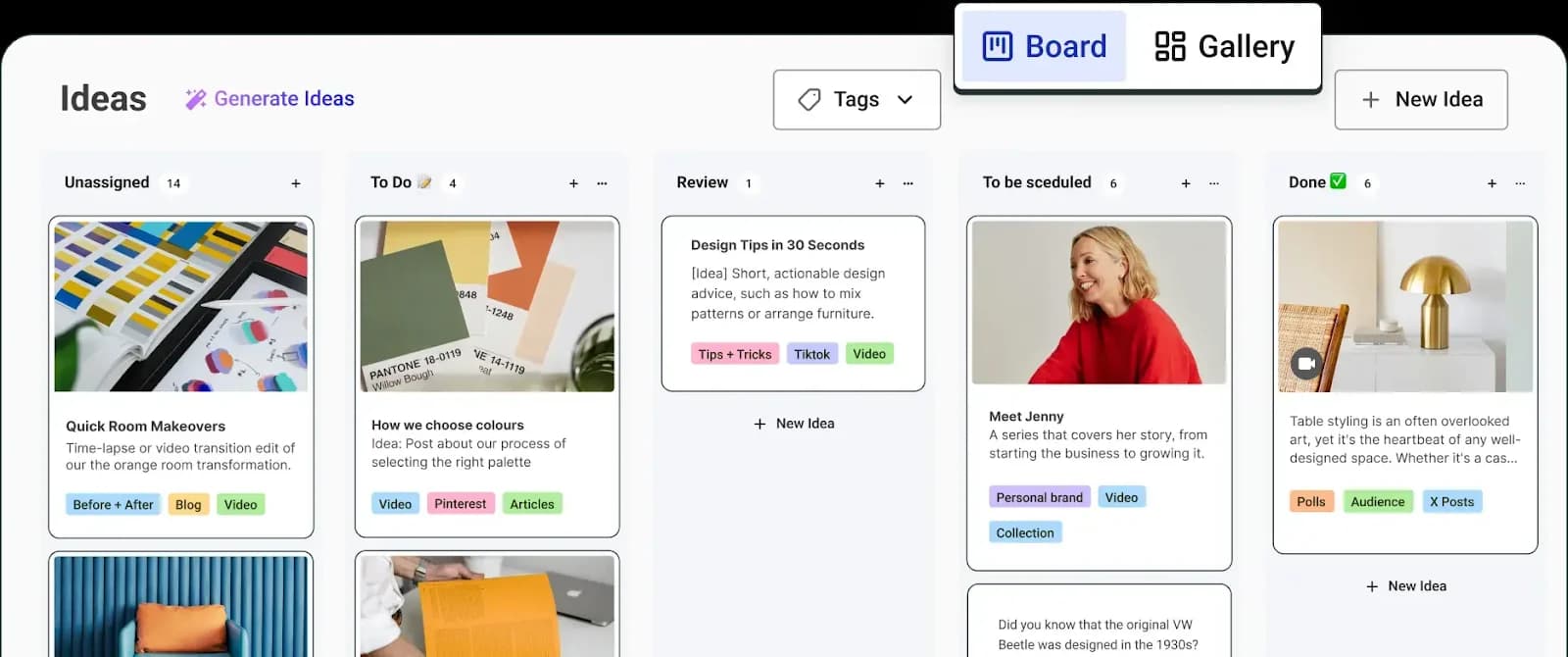
Buffer's analytics are simple but not deep. However, they provide enough data to report to clients on what’s working, track engagement, and show progress.
It won’t offer the level of granularity some enterprise tools offer, but it’s usually enough for small to mid-sized agencies.
Buffer also makes collaboration smoother. You can assign roles and collaborate on content drafts for approval. You can also add your logo to reports and generate a cover page.
The trade-off in Buffer is that it doesn’t have the extensive integrations or custom reporting options that some more complex tools offer.
But for agencies that need a tool that’s easy to use and budget-friendly, Buffer does the job.
Pricing
Buffer’s pricing is channel-based and starts at $6 per month per channel. However, team features like approval workflows, custom access and permissions, and branded reports are only available in the team plan, starting at $12 per month per channel.
SocialPilot
Social Integrations: Facebook, Instagram, X, LinkedIn, Pinterest, TikTok, Google Business Profile, YouTube, and more.
SocialPilot is purpose-built for agencies juggling multiple clients and platforms.
It’s one of the most affordable tools with agency-grade features.
What sets SocialPilot apart is its clean UI, scalable client management, and white-label reporting, all without a per-user pricing trap.
The publishing dashboard supports bulk scheduling, content calendar views, and direct publishing for all major platforms. Teams can also save hours weekly with AI-based post generation and suggested best times to post.
Client collaboration is handled smartly—teams can assign roles, create content approval workflows, and even offer clients a dedicated content review link without forcing them to sign up.
The Social Inbox makes replying to DMs, comments, and mentions across platforms easy, and the filtering options help teams stay focused on what matters.
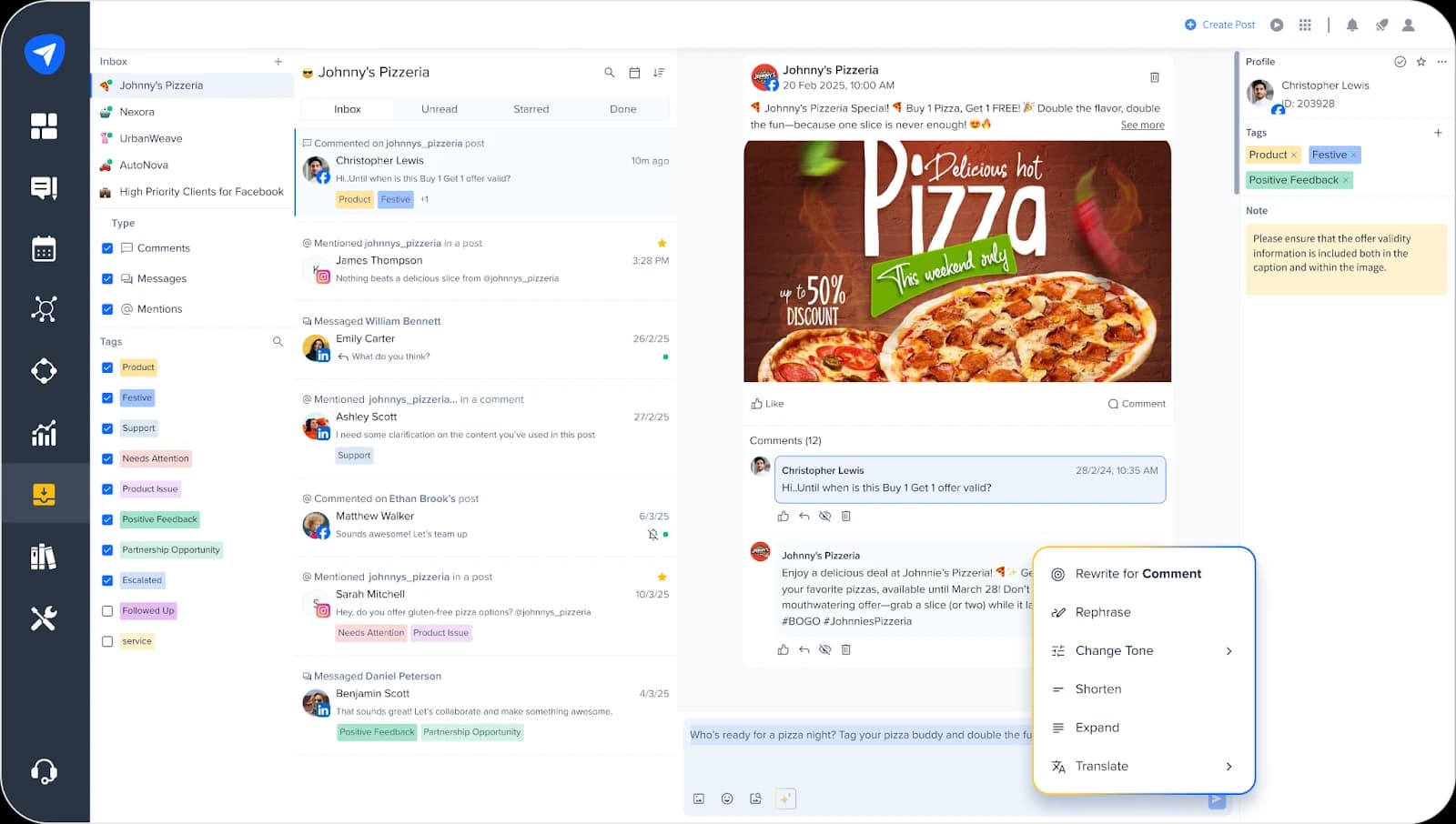
SocialPilot’s reporting is straightforward but customizable. Reports are client-ready, white-labeled, and include metrics that actually matter to SMBs and agencies alike.
Pricing: SocialPilot's pricing starts at $85.83/month for the Agency plan (no per-user fees), with support for up to 10 team members and unlimited clients.
Planable
Social Integrations: Facebook, Instagram, X, LinkedIn, Pinterest, TikTok, Google My Business, Threads, and YouTube.
If your agency’s biggest pain point is content reviews and client approvals, not in-depth reporting or inbox management, Planable nails that part.
What stands out to me is the way the content looks inside Planable.
Posts appear exactly as they will on each platform. That’s especially useful when you’re presenting content to clients. You show them exactly how a post will look once it’s live.
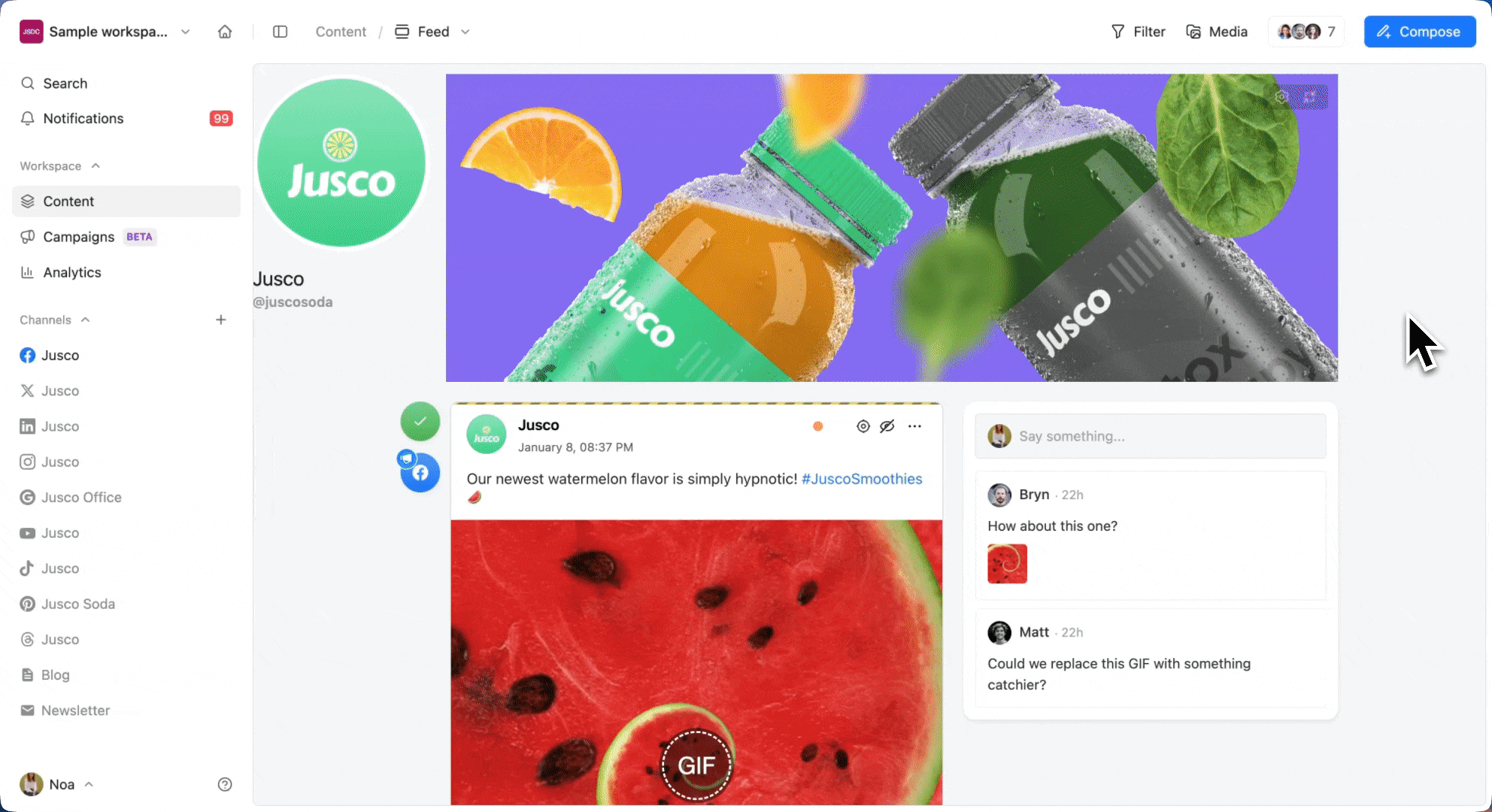
Clients or teammates can leave comments right on the post, approve or reject content with a click, and suggest edits in real time.
Scheduling content is also simple. Posts can be automatically scheduled once approved, without any extra steps.
You can track every edit with Planable’s version history feature, with the option to revert to previous versions if necessary.
You can reuse posts across different pages or workspaces with just a click.
One thing that’s clear: Planable is built for teams. You can control who sees what, assign roles, and limit access by workspace.
That helps when you’re managing different clients with varying levels of involvement. Whether a client just wants final approval or wants to see every step, you can adjust the setup without rebuilding the entire workflow.
Planable’s analytics aren’t as deep as those of tools like Statusbrew or Sprout Social. It also does not offer an inbox or listening tools. But for many agencies, the trade-off is worth it.
Pricing
Planable's pricing structure is workspace-based, starting at $39 per month per workspace.
Unlike user-based models, Planable lets agencies scale their teams by allowing unlimited users in all plans.
However, each plan limits the number of posts you can create across all your pages in a workspace per month, as well as the number of pages in a workspace.
Analytics are available only as an add-on in all plans.
While the pricing is straightforward, the limitations on post volume and page count should be considered, especially for agencies with high-content needs.
Sendible
Social Integrations: Facebook, Instagram, X, LinkedIn, TikTok, Google My Business, Threads, and YouTube.
One of the features I’ve appreciated most for agencies is Sendible’s white-label solution. It lets you offer a client-facing experience that looks and feels like your own platform.
You can add your agency’s logo, match the interface to your brand colors, and even use a custom domain. This can go a long way in building trust and professionalism.
The built-in content calendar is interactive. You can draft, edit, and move posts around with drag-and-drop.
Another feature I lean on a lot is Smart Posts. Instead of rewriting the same caption for five platforms, you tailor a single draft per network.
That’s especially helpful when you’re writing in different tones for different client brands or adjusting for character counts and formatting quirks.
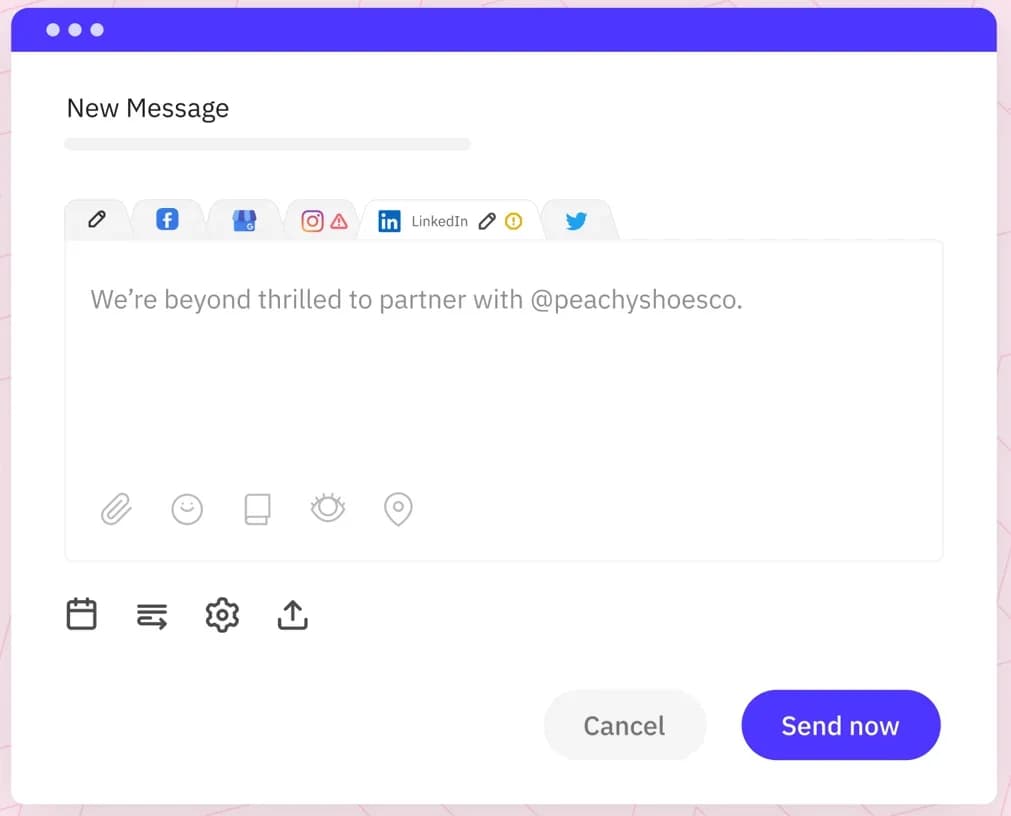
You can also recycle top-performing content or queue evergreen posts automatically.
Sendible also integrates well with other tools, including Canva, Dropbox, Google Drive, and Google Analytics.
On the collaboration front, Sendible makes it easy to manage roles and workflows. You can assign posts for approval, leave comments, and set up custom permissions for clients and team members. It’s not overbuilt, just enough to prevent confusion and back-and-forth.
Reports are customizable. You can automate them to go out on a set schedule.
Sendible isn’t trying to compete with the big enterprise platforms on data granularity or automation rules, but for small to mid-sized agencies, it hits the right balance.
Pricing
Sendible’s pricing starts at $89 per month for businesses with less than 5 employees. But for agencies, growing businesses, and resellers, the Advanced plan has been suggested starting at $299 per month. While label feature is available only as an add-on in Advanced and Enterprise plan.
eClincher
Social Integrations: Facebook, Instagram, X, LinkedIn, TikTok, Google My Business, Threads, Pinterest, and YouTube.
eClincher does not have the prettiest interface out there, but it’s built for function-first teams.
Where eClincher earns points for me is its visual calendar and queue-based scheduling.
You can set up smart queues based on categories (like promotions, blog content, or client announcements) and let them run automatically. That helps when you're managing long-term campaigns or need to keep certain types of content cycling.
Collaboration tools are there too, which you can use to assign tasks, share drafts, and manage approval flows, but they’re not overly complicated. That makes it usable even if your team or clients aren’t technical.
You also get media libraries, link shortening, and integrations with tools like Canva and Pocket.
The reporting side isn’t as polished as some higher-end platforms, but you do get access to customizable reports that are good enough for most client check-ins.
And there's a unified inbox for all social interactions, which cuts down the time you’d otherwise spend toggling between accounts.
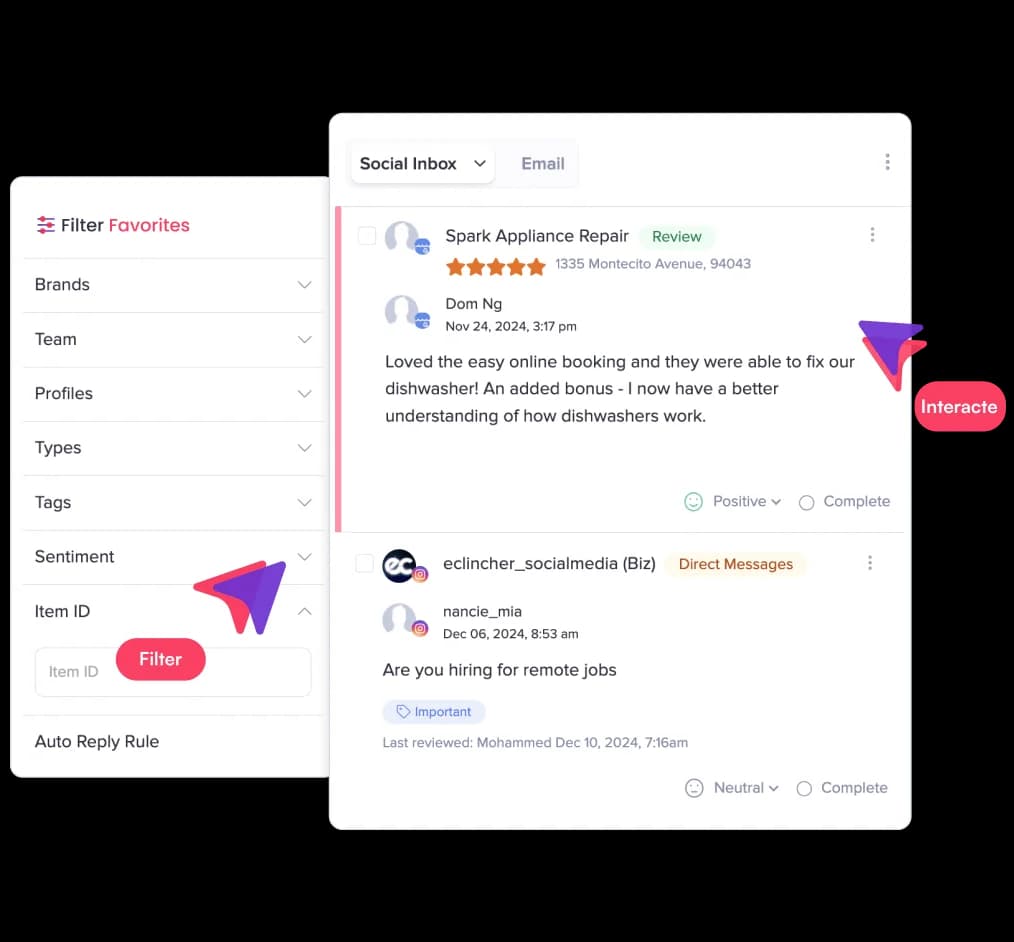
eClincher is not as well-known as Sprout or Hootsuite, but for agencies that care more about features and workflow support than brand name, it delivers on the value.
eClincher doesn’t stop at social. It covers local SEO, listing management, and brand monitoring.
Pricing
eClincher provides bundled pricing. The Professional Plan at $349 per month for 5 users and 25 profiles gives agencies a decent starting point.
But there’s a cap; this plan maxes out at 10 users and 40 profiles. For agencies scaling beyond that, they would have to opt for the Enterprise plan, which isn’t publicly priced and typically requires a custom quote.
Unlike some other tools that gatekeep core features behind higher plans, eClincher gives agencies access to features like approval workflows, AI-powered automation tools, and external client dashboards even in the Professional plan.
MeetEdgar
Social Integrations: Facebook, Instagram, X, LinkedIn, TikTok, Google My Business, Threads, and Pinterest.
If your agency is managing evergreen content and looking to automate the day-to-day posting without micromanaging every post, MeetEdgar is a must-have.
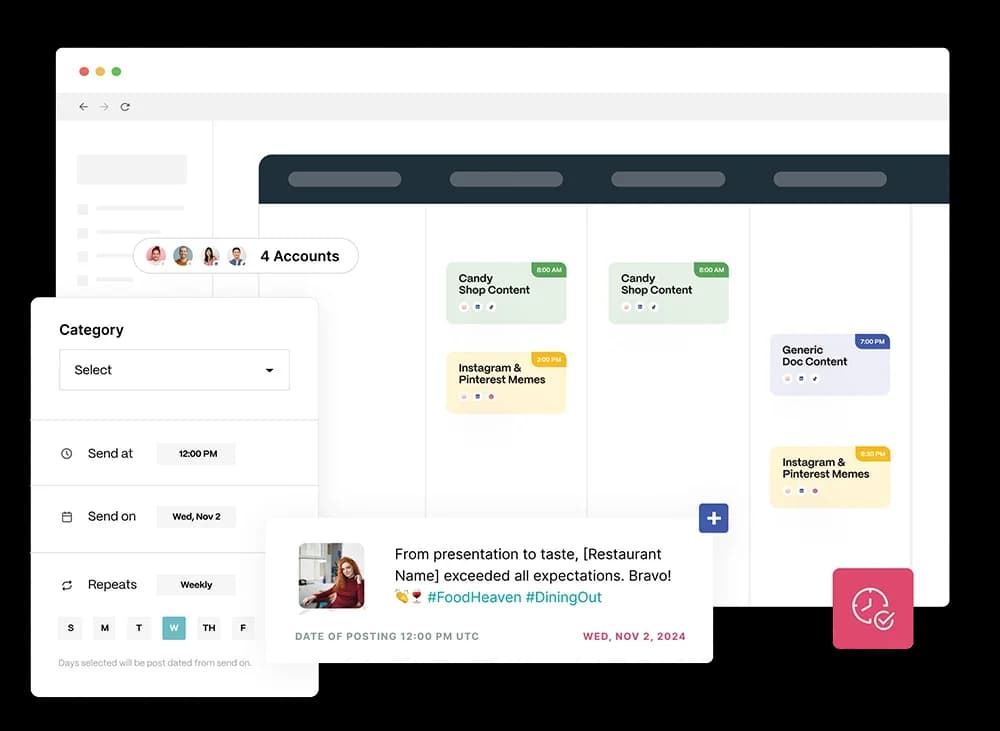
You’re not constantly being pulled back into manually reposting content or filling empty gaps in a calendar. Once you’ve loaded up a batch of evergreen posts and added a few variations, Edgar handles the rest.
Another feature that stands out to me is how it pulls fresh content through RSS feeds.
Whether you’re working with WordPress blogs, Vimeo, Medium, or anything Zapier connects to, Edgar checks for updates every night and loads fresh content into your queue.
That saves a ton of time, especially when your clients are publishing regular content and you just need to keep the social feeds updated.
Where it does fall short is that it's not built for heavy collaboration, community management, or detailed reporting.
Reporting is bare-bones, good enough to show posts going out, but not deep enough for clients asking detailed performance questions.
So if your agency has complex workflows or needs deeper analytics, it might feel a bit limited.
For agencies handling repeat content or long-tail evergreen strategies, MeetEdgar is very helpful.
Pricing
MeetEdgar’s pricing starts at $49.99 per month for small businesses & social media teams.
It is capped by social accounts, weekly automations, team members, and AI credits.
Which is the Best Social Media Management Tool for Agencies?
There’s no single solution that fits every agency, and that’s the point. The “best” tool depends on how many clients you manage and what your day-to-day actually looks like.
Use this comparison to help filter your options.
Pick four tools that align with your priorities. Book demo calls with each.
Then, shortlist two and run them in parallel for at least 15-20 days. Involve your team, set up real workflows, and bring in a client or two. The goal isn’t just to test features; it’s to see how naturally the tool fits into your operations.
Look closely at how each tool prices its plans and how that pricing adjusts as your team and client list expand. The right platform should scale with your agency without unpredictable jumps in cost.
Choose a platform that supports your agency’s workflow without locking key features behind higher plans.
This isn’t about finding a tool with every possible agency feature. It’s about choosing the one that handles the priorities that actually impact your agency’s workflow, reporting, and client management.
FAQs
How to generate custom social media reports for clients?
Yes, Statusbrew makes it easy to generate customized reports for your clients without starting from scratch. You can build custom dashboards using a library of over 250 metrics and combine them with 11 types of visualizations. You can also start with one of the 20+ built-in report templates.
How to manage multiple social media accounts?
Use a centralized tool like Statusbrew, Buffer, Hootsuite, or Sprout Social. These platforms let you schedule posts, monitor engagement, and reply to comments/messages across different accounts from one dashboard.
Which are the best social media project management tools for agencies?
Tools like Statusbrew, Sprout Social, Hootsuite, and Buffer are the best social media project management tools for agencies. These platforms offer features for scheduling, monitoring, engagement, reporting, and team collaboration with options for managing multiple clients from a single dashboard.
How can you automate client approvals and content reviews?
Yes. Agency-focused tools offer workflows for drafting, editing, and submitting posts for client approval. Typically, clients can preview content, comment, suggest edits, and give final approval: all tracked within the platform.
What’s the difference between “project management” and “social media management”?
Project management features refer to workflow tools: task assignment, timelines, and internal communication. Social media management covers scheduling, publishing, engagement, and analytics. Top agency tools like Sprout Social, Statusbrew, and Hootsuite blend aspects of both for seamless teamwork.
Do these social media platforms integrate with other tools agencies use? Yes, Social media management tools can be integrated with agency tools like Canva, Dropbox, Google Drive, Slack, Teams, Bitly, and OneDrive to improve team collaboration. What kind of general and migration support is provided?
Customer support is usually provided through Live chat, Email, and 1:1 Zoom calls. Videos and help center guides are also available. Moreover, depending on the network, tools can help agencies backfill historic data upto 18 months.
What pricing model should growing teams or agencies look for while hiring a social management tool?
Price per user is actually not ideal for growing agencies. There are many features that some of the users don't need; for example, a client wants to review the calendar or check reporting, and that too, once a month. So, paying the full amount for that user doesn't make sense. It's better to go after a tool that provides bundle pricing, which includes a certain number of users and costs you per profile. This will allow you to collaborate and plan without a high price tag.



